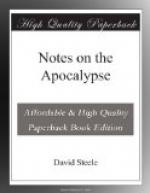With the 20th chapter of the Apocalypse terminate the events of time, in which the divine Author demonstrates, that “known unto him are all his works, from the beginning of the world.” (Acts xv. 18.) Many, indeed, of the learned and pious have supposed the remaining chapters of the Apocalypse, to be a description of the church on earth during the millennial period. But besides the series, coherence and dependence of the several parts of the book, precluding such retrogression, this interpretation overthrows the scriptural distinction between the militant and triumphant state of the church. And it is not to be thought out of place, that the inspired prophet should describe, by suitable emblems, the outline of the heavenly state; for this he has done briefly already in a number of instances. (See chs. ii. and iii., also ch. vii. 15, 17.)—Those who consider the last two chapters as a delineation of the church on earth, have first formed in their minds ideas of a corporeal or bodily presence of Christ, and of a literal and visible reign on the earth. Such views we have already shown to be without scripture warrant, yea against plain declarations of the Holy Spirit, (as Acts iii. 21; Matt. xvii. 11, 12; Heb. ix. 28.) Hence we shall contemplate the symbols of the following chapters,—except as incidents or allusions may render this incompatible,—as shadowing forth the glories of the church’s heavenly state.
CHAPTER XXI.
1. And I saw a new heaven and a new earth: for the first heaven and the first earth were passed away; and there was no more sea.
2. And I John saw the holy city, new Jerusalem, coming down from God out of heaven, prepared as a bride adorned for her husband.




